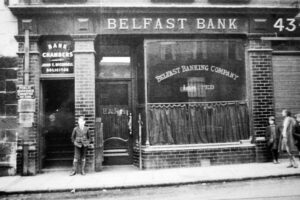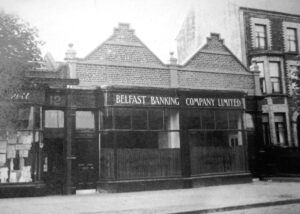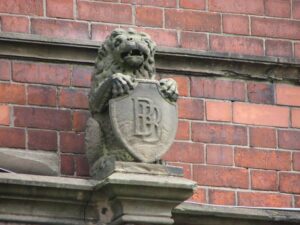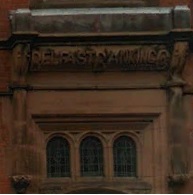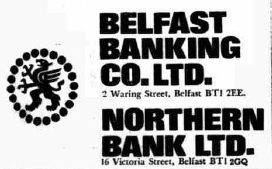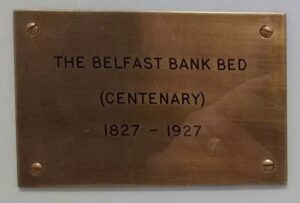As part of our #BelfastBlitz80 series, we publish an article by the late Ned Dyas, retired manager of the Northern Bank, Foreign Department, Victoria Street, Belfast. ‘Wartime in the Foreign Department’ was first published in the Northern Bank Staff Magazine ‘The Link’ in June 1993. Ned Dyas died on 14th October 2019.
Setting the scene

Northern Bank, Head Office, Victoria Street, Belfast
If you transfer your gaze momentarily to the left of the main door of the old Northern Bank, Head Office in Victoria Street you will see nearest the corner a tall window. This, double glazed and pretty sturdy, was the window to the world of the wartime Foreign Department of the Bank. A second window looked out, as it still does, onto Ulster Street and the building of G. Heyn & Sons Ltd. In the third wall stood a fireplace where a bright, richly burning fire greeted you each morning and the remaining wall was in fact an oak partition separating the room from the Bank’s main waiting room. Apart from the Manager’s large and imposing desk and those for the typists, a high solid desk stretched round two of the windowed walls. The staff either sat on high stools at this desk or more often than not stood and leaned! The high desk was essential to carry and spread the huge ledgers recording the transactions. The old-style telephones with separate earpieces were still in use. I well remember too that one of the cupboards held bundles and bundles of Reichsmark Notes dating from the collapse of the mark in the twenties. This was 1943 – fifty years ago.

Extract from a wartime fire prevention document completed
for Northern Bank, 110 Victoria Street branch.
Fire-watching at Head Office
Belfast had been the subject of its main air attack in 1941 and while our Head Office, like the Belfast, Ulster and National Banks, was very much in the target area being so near the shipyard it escaped any major damage. The other banks were similarly fortunate. A solitary incendiary bomb had left a hole in the floor of the Stationery Store and I remember having to step over this hole to get at our supplies. Fire-watching was at once a chore and a source of much needed extra remuneration as far as ‘juniors’ were concerned, so those of us in digs did as many nights as possible. Pay was at the rate of 3/= (three shillings) per night, in modern terms 15p but in real value more like £5 to-day [1993]. If you were lucky enough to be asked to do an extra night for a Director or Chief Cashier or other senior member of staff you could earn as much as 7/6d for the night. This as you may well imagine was regarded as a plum! When I tell you that our annual starting salary was £100 per annum plus a 16% War Bonus out of which in my case £78 went on digs you will see that the fire-watching shillings were valuable indeed. Many’s a nice-looking girl would not have been asked out without them. You cycled from your digs to the office, arrived for fire-watching about 10 pm, slept the night in the main waiting room or Foreign Department where the beds were assembled and cycled back for breakfast making sure that you would be back in good time for your day’s work. If you were going to arrive late for fire-watching you made a prior arrangement with a fellow watcher to let you in at the side door. Quite often the pulley bell on the great front door would clang out in the darkness to announce a late comer and I can remember on occasions seeing the face of the Albert showing midnight as I made my way down to the side door. We had an almost permanent firewatcher in Mick the porter. You would find him doing his football pools when you arrived in for duty. Almost completely deaf, he was nevertheless bright of eye, beaming smile and a loyal servant of the Bank. His favourite comment when you handed him a letter or parcel for delivery was “Thank you kind Sir, your kindness exceeds your personal beauty by far; your face I may forget but your kindness never.”
Dealing with the U.S. Forces
Northern Bank was first to operate a Foreign Department and was appointed by the Government as its Agent to deal with the U.S. Forces and authorised to deal with all foreign currency notes and coin on behalf of the Bank of England. This resulted not only in all the other Banks clearing their purchases of U.S. Dollar Bills, etc. to us on a weekly basis but also meant that we were in the front line for dealing with the U.S. Forces Finance Officers. Such sights as our Head Office Cash Office packed with U.S. Navy Personnel when a U.S. Cruiser or Destroyer docked in Belfast and the boys needed cash for the weekend were not infrequent. At such times we all became cashiers for an hour or so! On Pay Days when U.S. Finance Officers were drawing sterling cash for their Forces pay the steps on either side to the Main Door at Head Office would be lined by troops with rifles at the ready, all the way indeed from their bullion van in the street below to the very counter inside. There was an unofficial arrangement that the Bank would try to oblige Officers and Men of the Forces who were here for a longer spell and wanted cheques cashed.

Sailors queuing at the Belfast Banking Company, Bangor branch
It was, and probably still is, a very serious offence for U.S. service personnel to issue a dud cheque so the risk was not perhaps regarded as a major one. Nevertheless, we and the other Banks did have occasional trouble with unpaid cheques. I can recall cheques written out on ordinary sheets of paper shaped like a cheque being returned by our Agents not with “Refer to Drawer” or “Insufficient Funds” but with the ultimate answer “No such Bank”.
Glimpses of the Daily Routine
To outline the daily routine in the Foreign Department would be a bore but a couple of features I recall may be of interest. We received dozens of cables each day from the States asking us to make payments to individual U.S. Army personnel at Camps all over Northern Ireland and these were domiciled at our local Branches or with another Bank if we hadn’t a Branch in the nearest town. As many as 150-200 “Advices to Beneficiary” were despatched daily to these personnel. How’s that for a postage book! [Editor: every outgoing letter had to be detailed in a hand written ledger]. Not only that but happily the Linen Industry kept its flag flying right through the war. Linen was still in great demand in the U.S.A., Mexico, the Latin American countries, Cuba and the Caribbean Islands and in all the countries of South America. We might have had a dozen Registered Airmail letters a day containing Shipping Documents for Havana, Rio de Janeiro, etc. Despite the risks of war, I cannot recall us losing an original set of Shipping Documents, though duplicate documents were always sent on by surface mail (even more hazardous).
The Bank as a Family
Nostalgia has a habit of painting one’s memories in a rosy glow but I’m sure I’m not mistaken in saying that Banks of those days, not alone ours, were very much large families. And as in all families there were the lighter moments! I could tell you of duets in the Letter Department in the morning interrupted by our Bank Secretary, Hugh Murphy, a man of imposing stature but gentle in manner, asking with a broad smile when the Opera was beginning. Incidentally it was Mr. Murphy’s dictum that if you walked round the Office with a bundle of papers under your arm no one would ever ask you to do anything. To conclude, our small staff of eight or nine in the Foreign Department was kept at full stretch during this time but there was very much a family feel about all we did and to someone like myself (and, if I may include him, John Tunstead) coming from Dublin to Belfast and not knowing a soul it was good to find oneself among so many friends and so soon.

